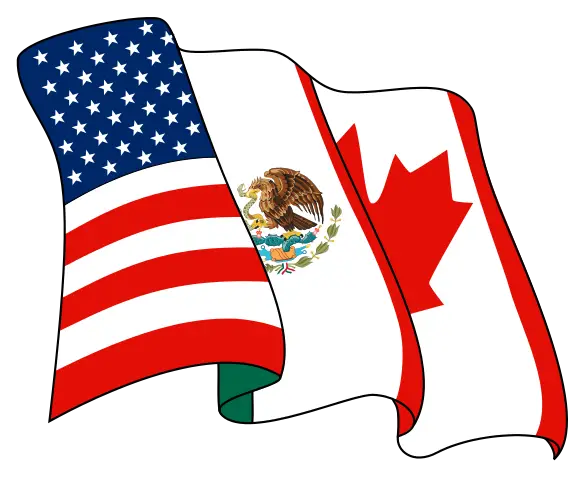- Acronym: NAFTA
- Type: Trade Bloc
- Membership: 3 member states
- Establishment: Established on 1 January 1994
- Official Language(s): English, Spanish, French
- Headquarters: N/A (NAFTA does not have a centralized headquarters; its administrative functions are handled in the respective member states)
The North American Free Trade Agreement (NAFTA) was a landmark trade agreement that removed most tariffs and trade barriers between the United States, Canada, and Mexico. Its primary purpose was to encourage economic integration between these North American countries.
NAFTA History
NAFTA was signed on December 17, 1992, by the leaders of the United States, Canada, and Mexico and came into effect on January 1, 1994. It created one of the world’s largest free trade zones and laid the foundations for strong economic growth and rising prosperity for Canada, the United States, and Mexico. In 2020, NAFTA was replaced by the United States-Mexico-Canada Agreement (USMCA).
NAFTA Structure
NAFTA operated through a series of agreements and regulations that were enforced by each member country’s governmental agencies. Disputes within NAFTA were resolved through international tribunals. Various committees and working groups were established to manage and oversee the implementation of the agreement and to ensure that the objectives of NAFTA were being met.
NAFTA Membership
The membership of NAFTA included:
- United States
- Canada
- Mexico
NAFTA Objectives
Remove Trade Barriers
NAFTA’s main objective was to eliminate barriers to trade and investment between the U.S., Canada, and Mexico.
Increase Investment Opportunities
The agreement sought to provide a more predictable investment climate and enhanced protection for investors.
Protection of Intellectual Property Rights
NAFTA aimed to improve the enforcement of intellectual property rights among the member countries.
Environmental and Labor Protection
The agreement also included side agreements that aimed at cooperation over labor and environmental issues among the member countries.
NAFTA Funding
NAFTA did not have a centralized funding mechanism. However, administrative costs related to the trade agreement were handled by each member state according to its own national procedures.
NAFTA Projects
NAFTA primarily focused on creating a free trade area and did not fund specific projects like a development bank or international organization might. Its main “project” was the ongoing reduction of trade barriers and the facilitation of cross-border commerce among the member states.
NAFTA Members
Full Members
- United States
- Canada
- Mexico
Although NAFTA has been replaced by the USMCA, it remains an important part of the economic history between the United States, Canada, and Mexico. The agreement transformed the economic landscape of North America and its legacy continues to influence trade relations and economic policy in the region.

